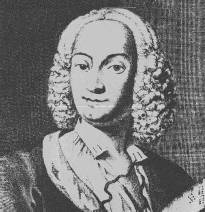Introduction
(born Venice, 4 March 1678; died Vienna, 28 July 1741).
He was the son of a professional violinist who played at St. Mark's
and may have been involved in operatic management. Vivaldi was trained
for the priesthood and ordained in 1703 but soon after his ordination ceased
to say Mass. he claimed this was because of his unsure health (he is known
to have suffered from chest complaints, possibly asthma or angina). In
1703 he was appointed maestro di violino at the Ospedale della Pietà,
one of the Venetian girls' orphanages; he remained there until 1709, and
held the post again, 1711-16; he then became maestro de' concerti.
Later, when he was away from Venice, he retained his connection with the
Pietà (at one period he sent two concertos by post each month).
He became maestro di cappella, 1735-8; even after then he supplied
concertos and directed performances on special occasions.
Vivaldi's reputation had begun to grow with his first publications:
trio sonatas (probably 1703-5), violin sonatas (1709) and especially his
12 concertos L'estro armonico op.3 (1711). These, containing some
of his finest concertos, were issued in Amsterdam and widely circulated
in northern Europe; this prompted visiting musicians to seek him out in
Venice and in some cases commission works from him (notably for the Dresden
court). Bach transcribed five op.3 concertos for keyboard, and many German
composers imitated his style. He published two further sets of sonatas
and seven more of concertos, including La stravaganza op.4 (circa
1712), Il cimento dell'armonia e dell'inventione (circa 1725, including
'The Four Seasons') and La cetra (1727). It is in the concerto that
Vivaldi's chief importance lies. He was the first composer to use ritornello
form regularly in fast movements, and his use of it became a model; the
same is true of his three-movement plan (fast-slow-fast). His methods of
securing greater thematic unity were widely copied, especially the integration
of solo and ritornello material; his vigorous rhythmic pattems, his violinistic
figuration and his use of sequence were also much imitated. Of his circa
550 concertos, circa 350 are for solo instrument (more than 230 for violin);
there are circa 40 double concertos, more than 30 for multiple soloists
and nearly 60 for orchestra without solo, while more than 20 are chamber
concertos for a small group of solo instruments without orchestra (the
'tutti' element is provided by the instmments all playing together). Vivaldi
was an enterprising orchestrator, writing several concertos for unusual
combinations like viola d'amore and lute, or for ensembles including chalumeaux,
clarinets, horns and other rarities. There are also many solo concertos
for bassoon, cello, oboe and flute. Some of his concertos are programmatic,
for example 'La tempesta di mare' (the title of three concertos). Into
this category also fall 'The Four Seasons', with their representation of
seasonal activities and conditions accommodated within a standard ritornello
form - these are described in the appended sonnets, which he may have written
himself.
Vivaldi was also much engaged in vocal music. He wrote a quantity of
sacred works, chiefly for the Pietà girls, using a vigorous style
in which the influence of the concerto is often marked. He was also involved
in opera and spent much time travelling to promote his works. His earliest
known opera was given in Vicenza in 1713; later he worked at theatres in
Venice, Mantua (1718-20), Rome (probably 1723-5), possibly Vienna and Prague
(around 1730), Ferrara (1737), Amsterdam (1738) and possibly Vienna during
his last visit. He was by most accounts a difficult man; in 1738 he was
forbidden entry to Ferrara ostensibly because of his refusal to say Mass
and his relationship with the singer Anna Giraud, a pupil of his with whom
he travelled. More than 20 of his operas survive; those that have been
revived include music of vitality and imagination as well as more routine
items. But Vivaldi's importance lies above all in his concertos, for their
boldness and originality and for their central place in the history of
concerto form.
Extracted with permission from
The Grove Concise Dictionary of Music
edited by Stanley Sadie
© Macmillan Press Ltd., London. |
Detailed Information about
-
The Four Seasons
-
Picture Gallery
-
List of Works
-
Bibliography
can be found on the internet on:
Classical Music Pages:  |
This project was created by Matt Boynick.
© 1 February 1996
Last Revision - 25 August 1999
|

